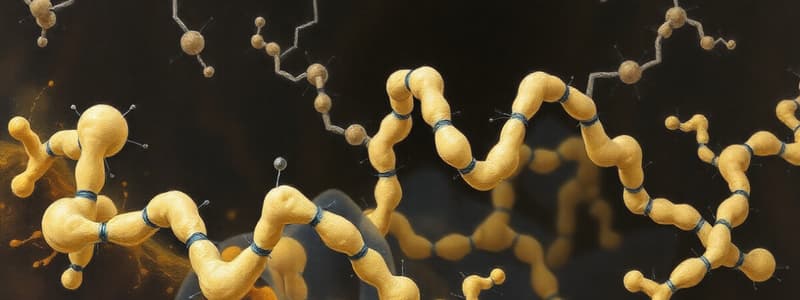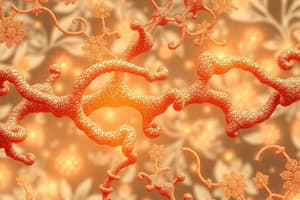Podcast
Questions and Answers
What is the primary structure of a protein?
What is the primary structure of a protein?
- The three-dimensional shape of the protein
- The aggregation of multiple polypeptide chains
- The arrangement of alpha helices and beta sheets
- The specific sequence of amino acids (correct)
Which type of amino acids can carry a positive charge?
Which type of amino acids can carry a positive charge?
- Polar neutral amino acids
- Essential amino acids
- Nonpolar amino acids
- Charged amino acids (correct)
How are peptides formed between two amino acids?
How are peptides formed between two amino acids?
- By the reaction of the side chains of the amino acids
- By direct fusion of two amino acid molecules
- Through ionic bonds between the amino groups
- By the reaction of the carboxyl group of one amino acid with the amino group of another (correct)
What distinguishes complex proteins from simple proteins?
What distinguishes complex proteins from simple proteins?
What is an example of a function served by proteins?
What is an example of a function served by proteins?
Which structure of a protein is characterized by the folding of polypeptide chains into a three-dimensional shape?
Which structure of a protein is characterized by the folding of polypeptide chains into a three-dimensional shape?
Which of the following describes the isoelectric point (pI) of an amino acid?
Which of the following describes the isoelectric point (pI) of an amino acid?
Which type of protein structure involves multiple polypeptide chains assembled together?
Which type of protein structure involves multiple polypeptide chains assembled together?
Aké skupiny aminokyselín existujú na základe ich postranných reťazcov (R-skupín)?
Aké skupiny aminokyselín existujú na základe ich postranných reťazcov (R-skupín)?
Čo sa vytvára pri reakcii medzi dvoma aminokyselinami?
Čo sa vytvára pri reakcii medzi dvoma aminokyselinami?
Ako je definovaný izoelektrický bod (pI) aminokyseliny?
Ako je definovaný izoelektrický bod (pI) aminokyseliny?
Aké vlastnosti majú proteíny vo všeobecnosti?
Aké vlastnosti majú proteíny vo všeobecnosti?
Ktorá z nasledujúcich štruktúr proteínu je definovaná ako usporiadanie reťazcov aminokyselín do alfa helixu alebo beta listu?
Ktorá z nasledujúcich štruktúr proteínu je definovaná ako usporiadanie reťazcov aminokyselín do alfa helixu alebo beta listu?
Ktorý z nasledujúcich proteínov je príkladom jednoduchého proteínu?
Ktorý z nasledujúcich proteínov je príkladom jednoduchého proteínu?
Aké typy proteínov možno označiť ako komplexné proteíny?
Aké typy proteínov možno označiť ako komplexné proteíny?
Ktorá z funkcií proteínov nie je typická pre ich vlastnosti?
Ktorá z funkcií proteínov nie je typická pre ich vlastnosti?
Flashcards
Amino Acid
Amino Acid
A carboxylic acid derivative containing at least one amino group. Building block of proteins.
Peptide Bond
Peptide Bond
The chemical bond formed between two amino acids. It links amino group of one AA with carboxyl group of another.
Protein Primary Structure
Protein Primary Structure
The linear sequence of amino acids in a protein.
Protein Secondary Structure
Protein Secondary Structure
Signup and view all the flashcards
Protein Tertiary Structure
Protein Tertiary Structure
Signup and view all the flashcards
Protein Quaternary Structure
Protein Quaternary Structure
Signup and view all the flashcards
Isoelectric Point (pI)
Isoelectric Point (pI)
Signup and view all the flashcards
Simple Protein
Simple Protein
Signup and view all the flashcards
Aminokyseliny: typ R-skupiny
Aminokyseliny: typ R-skupiny
Signup and view all the flashcards
Aminokyseliny: vlastnosti
Aminokyseliny: vlastnosti
Signup and view all the flashcards
Čo je peptidová väzba?
Čo je peptidová väzba?
Signup and view all the flashcards
Typy proteínov
Typy proteínov
Signup and view all the flashcards
Primárna štruktúra proteínu
Primárna štruktúra proteínu
Signup and view all the flashcards
Sekundárna štruktúra proteínu
Sekundárna štruktúra proteínu
Signup and view all the flashcards
Terciárna štruktúra proteínu
Terciárna štruktúra proteínu
Signup and view all the flashcards
Funkcie proteínov
Funkcie proteínov
Signup and view all the flashcards
Study Notes
Proteins, Amino Acids, Peptides
- Proteins are high-molecular weight organic substances, a fundamental component of all cells.
- Proteins are composed of amino acids.
- Proteins are broken down into amino acids during digestion.
- Amino acids are the building blocks of proteins.
- The sequence of amino acids determines the protein's structure and function.
- Living organisms synthesize proteins from the 20 amino acids.
Amino Acids
- They are organic derivatives of carboxylic acids, which minimally contain one amino group.
- Amino acids are coded in the genetic material.
- There are 20 common amino acids.
Properties
- Amphoteric (both acidic and basic character).
- The isoelectric point (pI) is the pH at which the molecule's net charge is zero.
- The pI of an amino acid is determined using the number of amino and carboxyl groups.
Peptides
- A peptide is formed when two amino acids bind together in a reaction that involves the removal of a water molecule.
- The amino acid that begins the chain is the N-terminal amino acid.
- The amino acid at the end of the chain is the C-terminal amino acid.
- Different combinations of amino acids form different peptides with different functions.
Important Peptides
- Hormones (e.g., insulin, oxytocin)
- Antibiotics (e.g., actinomycin)
- Many animal and plant toxins are peptides.
Proteins
- Proteins can be solid crystals, fibers, or colloids.
- They may dissolve in weak acids or bases.
- They are large molecules.
Protein Structure
- Primary: The linear sequence of amino acids.
- Secondary: Geometric structure of the peptide chain (alpha helix and beta pleated sheet).
- Tertiary: 3-dimensional structure of proteins, and the way polypeptide chains are folded. Two types of protein structure: globular and fibrillar.
- Quaternary: If the protein is aggregated of multiple protein subunits.
Protein Functions
- Structural: Support and shape.
- Hormonal: Communication between cells.
- Chemical: Enzymes (catalysts of biochemical reactions).
- Transport: Movement of substances.
- Regulatory: Control of cell activities.
- Protective: Antibodies and blood clotting factors.
- Contractile: Muscle protein involved in functions.
- Storage: Temporary storage of minerals and substances.
Protein Classification
- Simple: only amino acids
- Conjugated: amino acids plus other organic or inorganic components. Examples of conjugated proteins: lipoproteins, glycoproteins, phosphoproteins, metalloproteins, and nucleoproteins.
Studying That Suits You
Use AI to generate personalized quizzes and flashcards to suit your learning preferences.




